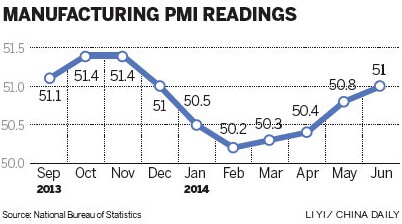

A worker cuts steel bars on the production line of a mill in Lianyungang, Jiangsu province. The official manufacturing Purchasing Managers Index for June stood at 51, the fourth consecutive month-on-month rise this year. Si Wei / For China Daily

Manufacturing numbers stand in sharp contrast with weakened property sector
Two gauges of China's manufacturing sector released on Tuesday point to sustained expansion in factory activity, with government stimulus efforts paying off, according to analysts.
The expansion contrasts with further weakness in the real estate sector. Experts said that what happens to the economy in the coming months depends on which proves stronger: the factory sector or property activity.
The official Purchasing Managers Index for June, jointly issued by the National Bureau of Statistics and the China Federation of Logistics and Purchasing, stood at 51, the fourth consecutive month the gauge has risen.
The final reading of the PMI jointly issued by HSBC Holdings Plc and Markit Ltd, also for June, rose to 50.7 from 49.4 in May, surging past the 50-point level that separates growth from contraction for the first time since December.
The HSBC/Markit index is weighed more toward smaller and private manufacturing companies.
"The rise of both figures suggests that the growth momentum has been picking up because of recent pro-growth policies", including infrastructure investment and more budget spending, Liu Ligang, greater China chief economist at Australia and New Zealand Banking Group Ltd, said in a note.
Premier Li Keqiang's recent pledge to safeguard the economic growth goal indicates that the "overall policy stance will become more supportive for growth in the second half", Liu wrote.
As part of the pro-growth policy, the way loan-to-deposit ratios are calculated also has been revised to give banks more capacity to lend.
The central bank also has lowered the reserve requirement ratio for banks that direct loans to rural borrowers and smaller companies.
A closer look at the PMI data has given the market greater confidence in the trajectory of the recovery. All but one of the major five sub-indexes of the official PMI improved month-on-month.
Most experts said the government's stimulus measures have reversed the nation's economic deceleration for the moment, but more must be done to solidify the trend.
"There are still downside risks due to a property market slowdown, which will continue to put pressure on growth in the second half of the year. We expect both fiscal and monetary policy to remain accommodative until the recovery is sustained," said Qu Hongbin, chief economist for China at HSBC.
Chang Jian, chief China economist at Barclays Plc, said in a note: "We think more policy easing, whichever form it takes, is unavoidable."
But beyond the monthly headline numbers, many economists fear it will be hard for China to achieve the 7.5 percent GDP growth goal.
"China can't realize the official growth target without extra stimulus. You can see it since 2012: Every time stimulus ceased, the growth rate dropped," said Chen Xingdong, managing director and chief economist of BNP Paribas Group (Asia).
"Most global investors now believe China's endogenous growth momentum has declined to below 7 percent. They will assume a 6 to 6.5 percent growth prospect for China when they make investment projections. That's not necessarily bad, because they've become sober and less ambivalent," he said.
Yuan Gangming, an economics professor at Tsinghua University in Beijing, said the government has to take measures to prop up the property sector if "you don't want a sharp correction".
Stimulus helps PMIs post best showing
2014-07-02China‘s June PMI shows economy stabilizing
2014-07-01China‘s June PMI at six-month high
2014-07-01China‘s non-manufacturing PMI rises in May
2014-06-04Service PMI posts best record in 6 months
2014-06-04HSBC PMI shows economy is stabilizing
2014-06-03Copyright ©1999-2018
Chinanews.com. All rights reserved.
Reproduction in whole or in part without permission is prohibited.